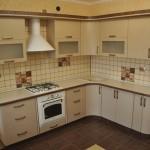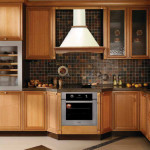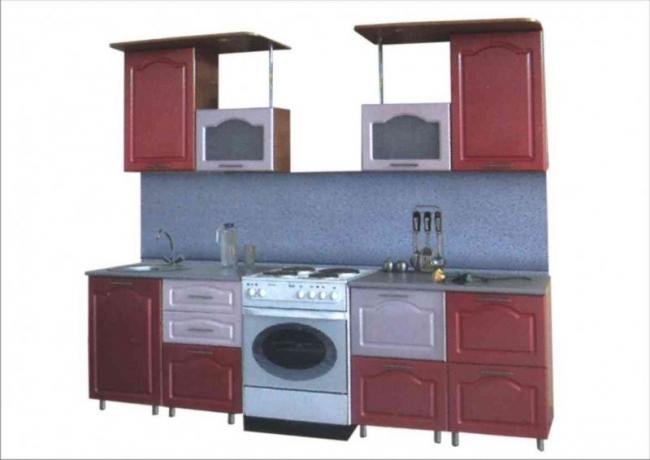Content
- 1 Types of kitchen modules
-
2 Kitchen module design
- 2.1 Frame
- 2.2 Facades
- 2.3 Fittings
-
3 Installation of lockers
- 3.1 Solid wall mounting
- 3.2 Cavity Wall Mount
The basis of any headset is a variety of kitchen cabinets. These elements form the internal space required for storing food, dishes and kitchen utensils, and thus ensure the convenience of using the room itself.
By purchasing cabinets and cabinets of different design for the kitchen, we can create a set that will fully meet our requirements. But to do this, we need to understand all the nuances associated with kitchen modules.
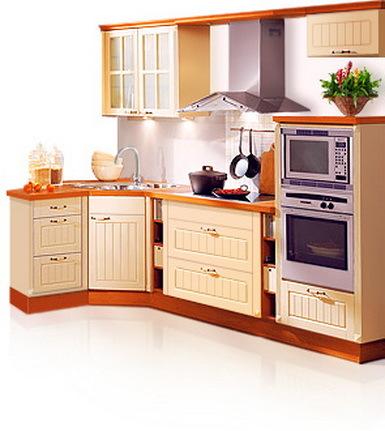
It is impossible to imagine a kitchen without storage space for various utensils!
Types of kitchen modules
When choosing a wardrobe for the kitchen, we will surely come across the fact that the catalogs of furniture companies contain a variety of models of these elements. What can manufacturers offer us?

The lineup is very wide
- Wall cabinets are one of the most common types of kitchen modules. Wall cabinets are most often equipped with swing or sliding facades (doors), while the interior space is divided into several horizontal sections by open shelves.
- Floor stands - act as a base for the countertop (see also the article on kitchen base cabinet). With a hinged facade structure, shelves are installed inside, and the curbstone can also be equipped with drawers.
- Both mounted and floor modules can be either straight or angled. In this case, the upper and lower bases have a pentagonal shape, and the facade is made in such a way that the elements installed on the sides do not interfere with its opening.

The simplest corner design
- A separate category is made up of the so-called showcases. The cabinet-showcase for the kitchen is a structure (wall-mounted or high, from floor to ceiling) with a transparent front wall. As a rule, sets and other decorative utensils are stored in showcases.
- A fume hood for a kitchen is a kitchen module, inside which a hood is installed. Fume hoods are used infrequently for the kitchen, but they provide the most effective air purification, since hot steam from the stove or hob practically does not go beyond the boundaries of the space limited by the side walls.

Hidden hood
- A cabinet under the window in the kitchen is sometimes used as storage for food. Its upper part is made up of a tabletop combined with the window sill, and the facades are most often made sliding - so they interfere less even in the open state.
Note! If you equip a cold cabinet in the kitchen under the window, then it can be used to preserve some products that cannot be stored on regular shelves. This can partially "unload" the refrigerator.

Under-window storage for products
- A popular design is also a kitchen cabinet table (pictured). When unfolded, it looks like an ordinary dining table, and when folded it serves as a small cupboard for storing dishes.

Combination of table and cabinet for utensils
Separately, it is worth mentioning the modules in which the built-in appliances are located. Using a frame of a suitable size, we can integrate an oven, microwave, dishwasher into the headset. car, etc. In this case, the facade can be both the door from the headset kit and the front panel of the devices.
Kitchen module design
Frame
Regardless of the type and purpose, the kitchen cabinet consists of the following elements:
- Framewhich includes side, top and bottom walls as well as a back wall made of thinner material and inner shelves.
- Facade - swing or sliding doors. Also, the front panels of the drawers can act as a facade.
- Fittings - a set of mechanisms responsible for opening and closing the locker, as well as for performing specific functions (we will talk about them a little below).

Laminated chipboard
All these elements make up the kitchen cabinet.
Let's consider each of them in as much detail as possible:
The frames for most headsets today are made of laminated chipboard (chipboard, the surface of which is covered with a special polymer film).
- As a rule, in the manufacture of kitchen furniture, a large sheet of chipboard is cut into separate elements. In this case, the ends of the slab are exposed, which are not covered with lamination.
- In order to give the headset an aesthetic appearance, as well as to protect the walls of the kitchen modules from swelling and deformation, the ends are subjected to edging, pasting them with polymer tape or a special aluminum profile.
- The frame elements are connected to each other using Euro screws - special fasteners with rare and deep threads. Such screws do not destroy the chipboard structure, and the cabinet is quite strong and reliable.

Euro screw mount
- To facilitate the structure and reduce its cost, the back walls of the cabinets are made of fiberboard. An opening for household appliances can also be provided in the back wall - we will pass wires or hoses through it during installation.
Despite the fact that the frame is almost invisible behind the facades, when choosing kitchens and cabinets, you need to pay close attention to the quality of the material. The thing is that with active use, it is the base of the kitchen module that often falls into disrepair first.
Facades
The next element that needs to be considered is the cabinet facades, or their doors. This element determines the entire appearance of the kitchen, therefore, attention should be paid to its selection.

Wooden door
It is worth deciding what doors are needed for your headset when you have at least an approximate idea of the decoration of the room itself.
As for the material, the most popular are the following types:
- Laminated MDF doors are one of the most common solutions. The base is made of a composite material of medium density, up to 25 mm thick, covered with a durable polymer film. In most cases, the films repeat the color and texture of the wood, but there are also more exotic options (like stone, leather, etc.).

Facades from MDF under a tree
Note! Economy class kitchens can be equipped with doors made of laminated chipboard, i.e. from the same material from which the cabinet bodies are made. Such panels are quite cheap, but the appearance does not compete with more expensive options.
- As an alternative to lamination, plastic sheeting can be used. This coating is resistant to damage and retains its color and original beauty for a long time.
- Also, the MDF base is covered with multi-layer enamel. Enamel facades look very attractive, and the main reason for this is the pleasant gloss of the lacquer coating. The only drawback of this technology is the vulnerability of the outer layer to chips and scratches.

Enamelled kitchen
- Solid wood is the most beautiful, one of the most practical, and at the same time the most expensive material. If you want to save money, you can make doors from inexpensive wood with your own hands. But ready-made facades will cost you dearly, and the higher the quality of the wood, the higher the price will be.
- A separate category is made up of doors made of aluminum profiles. Plastic, laminated or painted panels, as well as decorative heat-strengthened glass can be used as filling of frame structures.
Fittings
Kitchen cabinet fittings are responsible for opening and closing them, as well as for performing other functions.
The most commonly used fittings are:
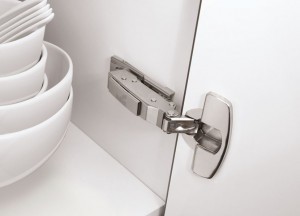
High-quality loop - a guarantee of your comfort
- Hinges are a universal element that ensures the movement of the kitchen module door. Quality hinges include friction brakes and polymer inserts that make the door move smoothly, smoothly and silently.
- Handles are the part we come into contact with most often. Cabinets and kitchens can be equipped with a variety of models, the main thing is that the coating is as durable as possible. In this case, even after several years of service, there will be no scuffs on the handle.
- Drawers are equipped with a special slide. A high-quality slide is a guarantee that even a narrow box will move easily, without getting stuck or twisting.
In addition to these elements, there may be other built-in hardware complexes:
- The bottle holder is a narrow pull-out lattice basket. Small bottles are placed vertically in it, and tall ones (for example, with champagne) can be stacked in special horizontal trays.

Retractable bottle fittings
- Lattice basket - usually installed under the sink. Unlike conventional shelves, it has a pull-out design that allows you to quickly get and put the items you need.
- Turntable (carousel) - can be installed in a corner cabinet to optimize free space. Also, recently, rotary shelves have been installed in the sideboard to make it easier to get the desired item out of a large service.

"Carousel" for the buffet
Installation of lockers
Solid wall mounting
If everything is more or less clear with the choice and configuration of modules, then you should proceed to the installation issue. As a rule, the lower parts of the headset do not cause much trouble: it is enough to level the pedestals in level and connect them, placing them on top with a table top.

Standard suspension
With wall cabinets, it is somewhat more difficult, since these elements must be securely fastened to the wall (see also the article on wall cabinets for the kitchen).
If the wall is solid, then this is done like this:
- First, we determine the location of the upper modules by measuring the distance from the top of the countertop to the lower edge of the hinged element. This distance must be at least 45 cm.
- Then, focusing on the location of the mounts on the back wall, we apply markings to the wall.
- According to the marking, we drill holes into which we drive dowels with anchor hooks.
- We hang the kitchen module on the hooks.
An alternative can be mounting on a special rail - a universal fastening profile with a protrusion for attaching brackets:

Rail mount
- We fasten the bus to the wall according to the marking using the technological holes.
- Inside the cabinets, we install brackets with special protrusions made of thick enough metal.
- Having lifted the module, we hook it with brackets on the bus.
Cavity Wall Mount
If the wall is sheathed with plasterboard, then the installation can be carried out either on special fasteners, or using a pre-laid timber - otherwise even a light locker with its mass will break sheathing:

Cavity wall plug
- When renovating the kitchen, we install a mortgage beam on the wall under the drywall. Narrow beams or boards with a thickness of at least 40 mm can be used as a bookmark.
- After sheathing the wall with gypsum plasterboard, we twist the metal anchors into the timber, and we hang the cabinet on them.
- If there is no timber behind the cladding, then you need to use special dowels. Such a dowel, when twisted, opens behind the drywall, and sticks to it from the back side. The fastening reliability is quite sufficient for a 12-mm gypsum board to withstand a standard kitchen module.
At first glance, this seems rather complicated, but the video instruction posted on our website explains in some detail all the nuances of the technology of mounting hinged elements.
There are quite a few nuances, but all of them must be taken into account. After all, whatever your kitchen is planned, the closet will always store the bulk of the dishes, utensils and accessories you need. And in order to use all this conveniently, it is important to choose the right cabinet for kitchen!
Gallery
